The Opus Ceramique
Not so much inside information has been published about these speakers. Generic information can be found in the Opus Ceramique product brochure. Most other info can be found in magazines or on the web.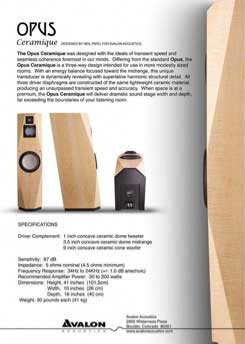
The cabinet
The format of the speaker cabinet with the cut-off edges, the angled form factor, and its volume obtained by the depth instead of the width, makes the loudspeakers’ appearance less colossal than square boxes.
[Avalon, 2006]
The dimensions (h x w x d) of the cabinet are about 100 x 26 x 40 cm. The weight is 41 kg. It is a bas reflex design, with the vent underneath the speaker. In Avalons' product brochure, the use of heavy baffles, sandwiches of different laminations with different densities, and acoustical tuning of drivers by internal parts is mentioned as properties of the cabinet. The following pictures from Avalons' factory tour and Soundstage show that the enclosures contain a lot of internal bracing and internal absorption.
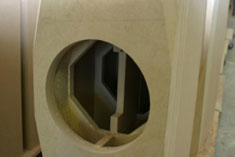
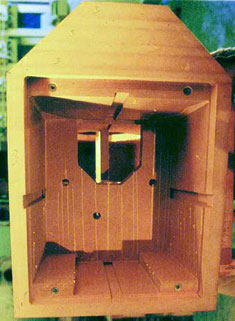
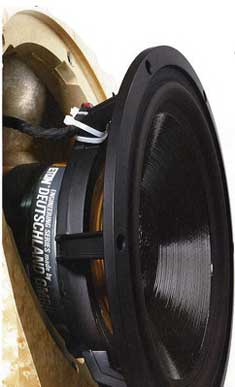
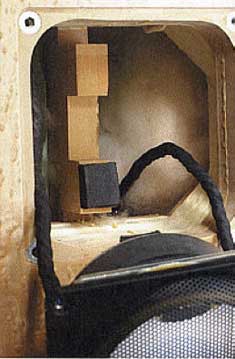
The units
The Opus Ceramique contains 3 ceramic drivers from Thiel & Partner (also known as Accuton). The tweeter is the C^2 12-6, the midrange the C^2 79-6, and the woofer the C^2 220-T6. More information about the drivers can be found in the Ceramique Stage or Measurement Stage on this website.The response
The average efficiency of the design is reported to be 87 dB/W (but measurements show it is more like 85dB/W), with a reported 5 Ohm impedance and 4.5 Ohm minimum (more like 3.8 Ohm in the operating range, and towards shortage above). Frequency range is reported to be 34 Hz to 20 kHz, +/- 1.0dB anechoic, but measurements show +2dB to -4dB.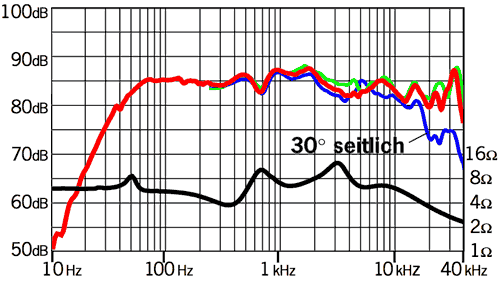
[Stereoplay, 1/2003]
From this frequency response, and supported by our own measurements and experiments, we can draw the following conclusions:
- When the overall average efficiency is 85dB, the bass starts to attenuate from 60Hz downward.
- The peak at 400-500Hz is caused by grill resonances, transported to the wooden cabinet (like a tuning fork).
- The dip at 700Hz is part of the midrange response curve. It is said that this is caused by the black "ears", that have been applied to dampen breakups in higher frequency regions.
- Avalon deliberately chooses to voice the response at 1-2kHz, and to dip at 3-7kHz.
- The response variations in the higher frequencies are caused by the tweeter response (dip at 4kHz, peak at 8kHz, dip at 12kHz, peak at 14kHz).
- Equalization has been applied to smoothen the impedance (e.g. normally the woofer inside the enclosure results in an impedance peak of 35 Ohm at 40Hz).
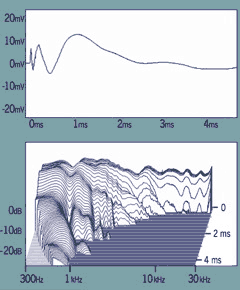
[Stereoplay, 1/2003]
Stereoplay concludes from this figure that the impulse response is not time-aligned, because tweeter, midrange and bass unit peaks are spread over time, but given the distance between the units, the outcome of such a measurements will be influenced by the position of the microphone. The waterfall diagram shows a "perfect decay above 1000 Hz", which according to Stereoplay “explains the pure sound”.
The article in Stereoplay refers to the secrecy of the crossover circuit, but says a bandpass filter is used for the tweeter, and only high quality components like foil capacitors, and manually winded inductors have been applied. The internal wiring is “tuned” to the separate units. The bass unit is connected to a cable consisting of very fine braided cable of 20 mm^2 in total. The midrange and tweeter are connected with larger stranded silver cable, surrounded by teflon.
On the website of Hunecke another measurement of the Opus Ceramique can be found, very similar to those of Stereoplay. The red anechoic curve shows some attenuated treble.
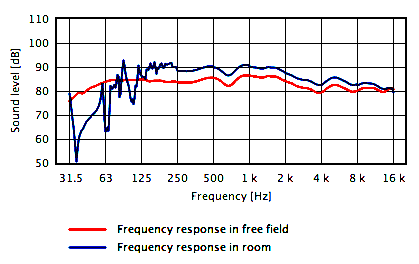
[Hunecke, 2006]
Another German magazine called Hifi & Records published some measurements in their 2/2006 issue. The measurements look very different from Stereoplay. First of all the response shows a significant 10dB dip above 4kHz. Secondly, there is a broad peek around 50Hz, and a broad dip around 200Hz. And last, but not least, the overall efficiency is 3 to 5dB higher. Maybe the difference hints at a redesign of the Opus Ceramique by Avalon?
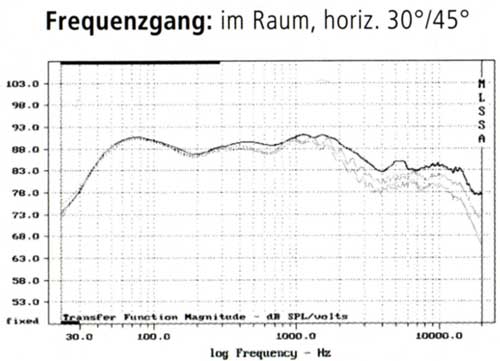
[Hifi&Records, 2/2006]
The response with vertical offset indicates a crossover frequency of 4kHz.
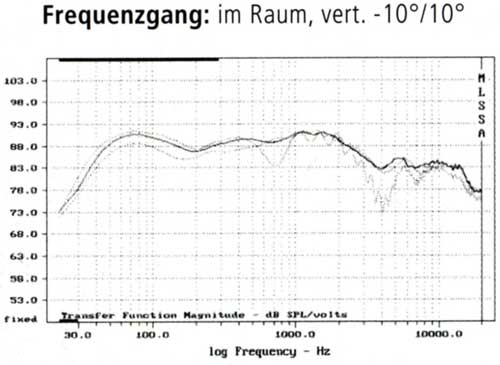
[Hifi&Records, 2/2006]
The impedance is also different from the Stereoplay figures (less flat). It shows a high peak at 45Hz.
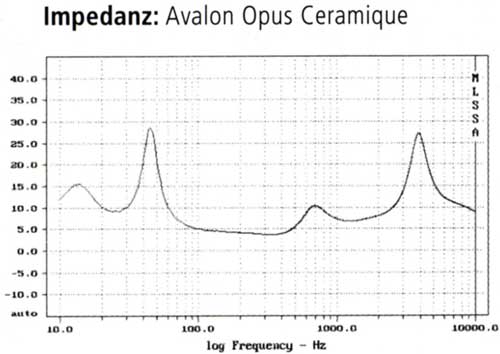
[Hifi&Records, 2/2006]
The waterfall is about the same, and impossible to compare anyway, as there are many ways to construct a waterfall from an impulse response.
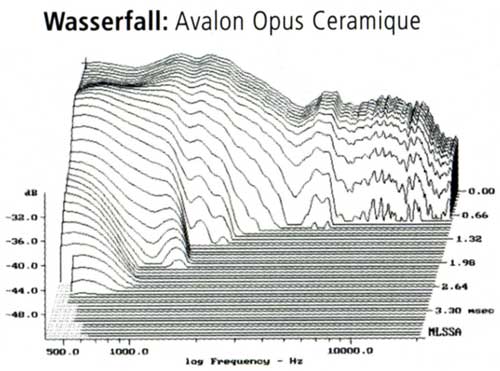
[Hifi&Records, 2/2006]
Avalon in their product brochure publish an impedance curve, that might hint at the impedance seen at the terminals of the C^2 79:
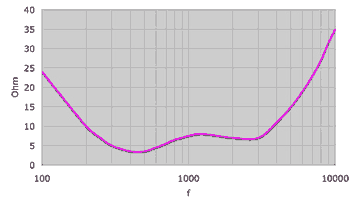
Some pictures (from the Avalon factory tour) show the use of cement resistors:
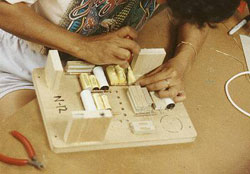
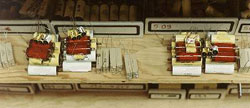

Opinions
The Avalon Opus Ceramique loudspeaker is generally praised for its neutral characteristics, transparency, lack of resonances and deep and wide stereo image. Stereoplay is impressed by the natural characteristics of the speaker, and rate the speaker among the best they know (whatever that might mean...).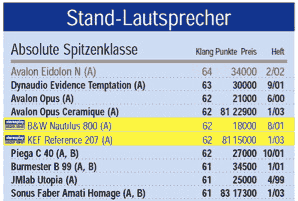
Some other reviews can be found from the Image magazine (German), Hifi&Records (German), and Stereoplay (German).
History
Thomas posted a summary about the history of Avalon speakers on the htguide forum.Conclusions
Filter- Crossoverpoints are roughly 300Hz and 3kHz (also see the Opus and Eidolon pages)
- Acoustic slopes of the near-field measurements are about 12dB/oct.
- [Stereoplay] a bandpass filter is used for the tweeter.
- [Audio] Lots of compensation networks are used to eliminate resonances from the units.
- [JonMarsh] When Neil refers to electrical networks, this is using a conjugate Zobel to neutralize the impedance rise of the speaker and make it look like a resistive load externally. This provides a measure of damping independent of the power amplifier (and it's feedback loop, if present).
- The pictures show the use of cement resistors.
- [HifiNews] The system is aligned to correct for delay times, providing accurate impulse wave shapes at the listener position.
- [JonMarsh] As presently designed, they're optimized for a listening window on the woofer/tweeter axis and somewhat above; going lower than the woofer brings out a slight dip in the crossover region. The crossover phase characteristic was compensated to deal with the driver acoustical offset which occurs with a flat baffle. With an Avalon style baffle, the tweeter is moved backwards, and this would launch the listening axis upwards a little more, unless the crossover is adjusted a bit.
- [Stereoplay] Only high quality components like foil capacitors, and manually winded inductors. The internal wiring is “tuned” to the separate units. The bass unit is connected to a cable consisting of very fine braided cable of 20 mm2 in total. The midrange and tweeter are connected with larger stranded silver cable, surrounded by teflon.
- [JonMarsh] Crossover components are very high grade; Solen Hepa Litz inductors and Solen capacitors- no iron core inductors or electrolytic caps, even for very large value capacitors. Internal wiring is with Cardas stranded Litz hookup wire, and guages were selected by listening as well as measurements.
Enclosure
- [HifiNews]. The enclosure of the Eidolon has a low-Q ‘sealed alignment (37Hz), 75 liters, and the reflex vent de-tuned to extend the extreme bass response (19Hz).
- Photos show a lot of internal bracing.
Vent
- Bass reflex port is tuned below 20Hz. On-paper measurements show a 5 cm diameter.
Grill
- [HifiNews]. The low diffraction absorbent grille provides an energy roll-of in the last one and a half octave.
next ->